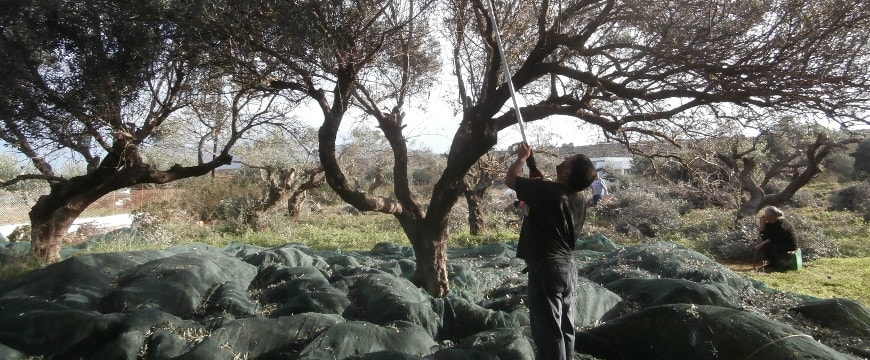Harvest time, method, and duration vary according to a number of factors, but harvesting tends to be labor intensive in Greece due to the country’s rocky, hilly, and mountainous terrain. Since ripening time varies according to the olive variety and location (including elevation), the harvest does not occur at the same time in all parts of Greece.
The olive harvest can begin with unripe green olives as early as September in some parts of the country. This is true for producers who wish to offer the extremely healthy “early harvest” extra virgin olive oil (or “agourelaio,” in Greek). Early harvest olive oil is prized by many who are accustomed to its strong, bitter taste.
Farmers seeking a larger quantity of olive oil and/or a milder tasting oil tend to wait for their olives to begin turning a dark color before harvesting, usually in November or later. Some wait until the olives are all completely ripe.
The harvest can take a few days or a few months, depending on the following factors:
- harvest method
- number of laborers
- number of olive trees
- type of terrain to be covered
In Greece, olive trees are often planted on rough terrain such as rocky hillsides and mountainsides. In such locations, large-scale harvesting by giant machines that surround the trees is not possible, as it is in parts of Spain and California. The olive harvest is therefore generally more labor intensive (and expensive) in Greece.
Greeks tend to use hand-held mechanical harvest aids that resemble long, thick broomsticks with long, thin fingers at the end. Those “fingers” move to help dislodge the olives. The harvesters gently knock the olives onto netting below the trees. Sieves can be used to separate the olives from the leaves.
Harvested olives are gathered and placed in burlap sacks or plastic crates, both of which let air in to help prevent the olives from heating up. Careful producers transport their olives to the mills the same day, in some cases within a few hours, for pressing. This enables them to avoid premature crushing and fermentation, helping to produce the best possible olive oil.
See the Photo Gallery’s Olive Harvest section for captioned photographs that illustrate the harvesting process.


